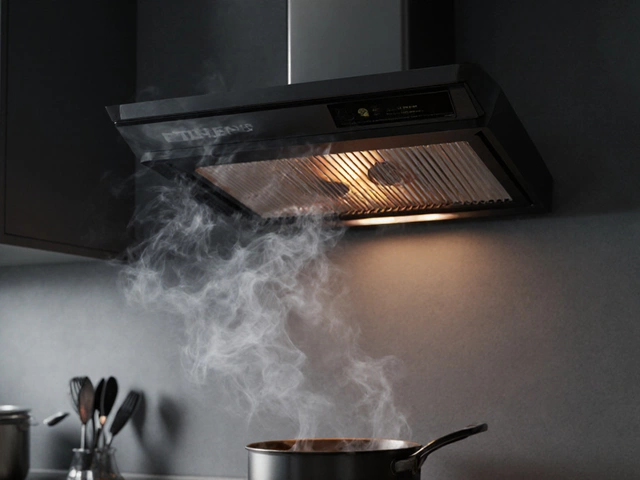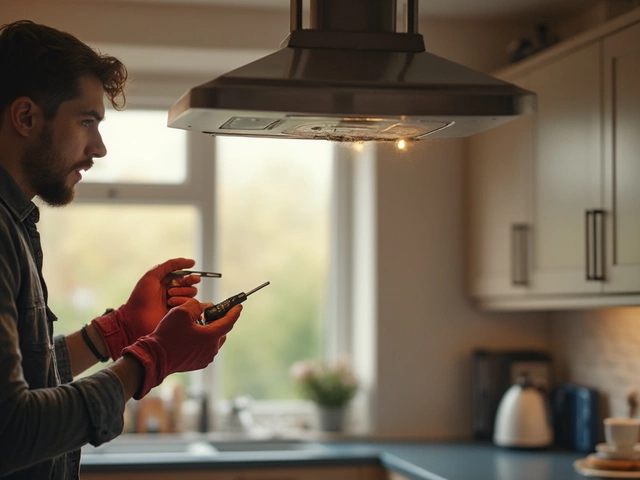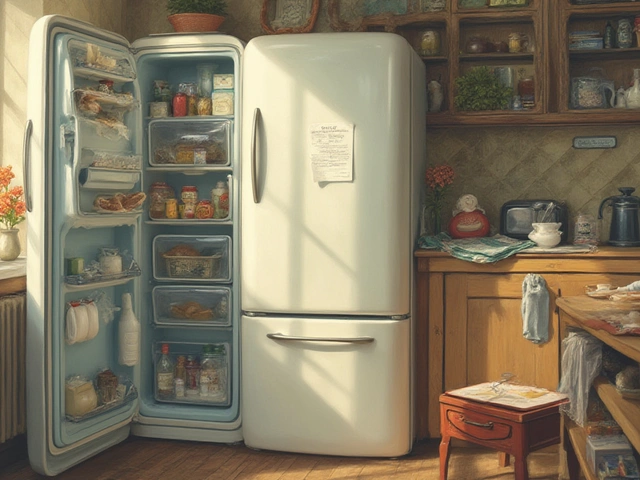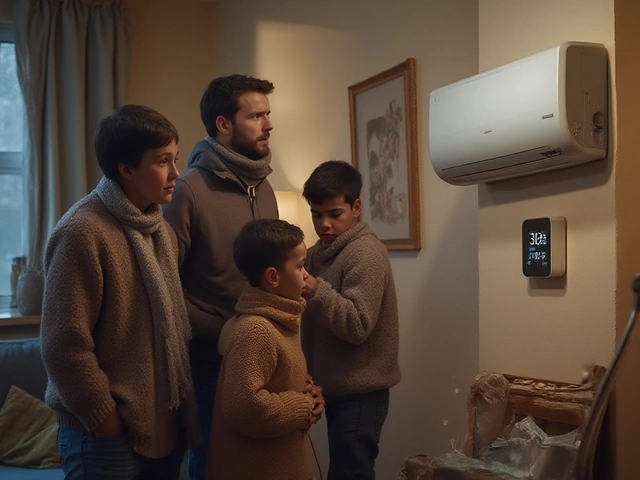Kitchen extractor fans might not be the most glamorous gadget in your cooking space, but they're the unsung heroes ensuring your kitchen isn't filled with smoke and unpleasant smells. These fans work hard to keep the air fresh by pulling out the steam, heat, and food odors while you whip up your culinary masterpieces.
To keep these devices running efficiently, testing and maintaining them should become a regular part of your kitchen care routine. This isn't just about making sure your home smells good post-dinner; it's about keeping the air healthy and the fan itself from wearing out prematurely.
Wondering how you can make sure your kitchen extractor is in top shape? With a little know-how, some household items, and a willingness to do a bit of detective work, you can easily test your fan and keep it in prime condition. Let’s dive in and look at some steps you can take to ensure your kitchen extractor fan is performing at its best.
- Understanding the Role of Kitchen Extractor Fans
- Safety First: Precautions Before Testing
- Testing the Fan's Suction Power
- Identifying and Fixing Common Issues
- Cleaning and Maintenance Tips
- When to Call a Professional
Understanding the Role of Kitchen Extractor Fans
Kitchen extractor fans are crucial components in modern homes, adeptly managing air quality while making meal preparations more pleasant. At their core, these extractor fans are designed to remove airborne grease, combustion products, fumes, smoke, heat, and steam from the air through filtration and evacuation. By maintaining a clean and odor-free environment, they ensure that your kitchen remains a hygienic and comfortable place for the entire family. Particularly in open-plan living spaces where kitchens blend with dining and living areas, the importance of an effective extractor fan cannot be overstated.
Extractor fans work by harnessing the power of mechanical ventilation. They either duct the unwanted byproducts outside, making them known as ducted models, or filter and recirculate the cleansed air back into the kitchen when they're ductless. This efficiency in operation hinges on the fan's ability to create an effective suction force, drawing in greasy air and filtering out particulates. The subtle mechanics of these fans revolve around the central motor-powered fan and intake system, often flanked by grease and charcoal filters to enhance air purity. With seasons of wear-and-tear and ongoing culinary adventures, these components require regular testing and maintenance to sustain their performance and longevity.
The installation location of these fans is another vital factor to consider. Positioned directly above or near cooking surfaces, usually within or above the range hoods, they capture particles right at the source. The best models possess multiple speed settings, offering various suction intensities to match different cooking intensities. Consider sauteing delicate garlic cloves which emit gentle aromas versus searing a steak that releases substantial smoke and grease – an extractor fan adjusts accordingly to manage these diverse byproducts efficiently. Moreover, the noise level becomes a factor due to its continuous operation during meal preparations. Advancements in technology have yielded quieter models, and this is an essential feature for many, ensuring that the fan’s operation doesn't detract from the kitchen's ambiance.
The Health Dimension
Beyond convenience and odor control, kitchen ventilation is paramount for health considerations. Cooking can generate a plethora of air pollutants such as nitrogen dioxide, carbon monoxide, and volatile organic compounds (VOCs), notably when gas stoves are involved. Prolonged exposure to these can influence respiratory wellness and overall indoor air quality. According to the Environmental Protection Agency (EPA), “indoor air pollutants can be 2 to 5 times higher than typical outdoor levels.”
"A well-maintained kitchen extractor fan is pivotal not just in providing comfort, but as a first line of defense against indoor air pollution risks," notes Dr. James Norton, a renowned expert in home environment safety.Effective extractor fans mitigate such risks, thus contributing to a safer home environment. They also protect kitchen surfaces from developing a sticky residue over time, which can harbor bacteria and other allergens.
Cost-effectiveness also comes into play with efficient extractor fans, presenting savings through energy efficiency while preserving your kitchen's look and feel. Contemporary fans are engineered to consume less power while producing better results, which consequently impacts electricity bills favorably. Technology continues to evolve, incorporating smart features such as automatic sensor operations that adjust according to air quality readings. Maintaining such modern systems translates to a commitment to sustainability, reducing the carbon footprint, and promoting both ecological and economic efficiency.
Safety First: Precautions Before Testing
Before you dive into testing your kitchen extractor fan, taking the right safety precautions is crucial. This isn't just about keeping your home equipment safe, but more importantly, protecting yourself from potential hazards. Whether you're a seasoned DIY enthusiast or just someone looking to ensure your fan runs smoothly, these safety steps are essential.
First, let's talk about electricity safety. The golden rule of handling any electric appliance is to cut off the power supply first. Locate the switch that controls the power to your extractor fan and turn it off. If you're unsure which switch it is, you can simply switch off power to the whole kitchen from your circuit breaker. This will prevent any accidental electric shocks that may happen if you accidentally touch exposed wires.
Another important factor is making sure you have the right gear. Wearing protective gloves can keep your hands safe from cuts or scrapes, especially when dealing with older models that might have sharper edges. Protective eyewear is also a good idea if you're planning to clean the fan or access dusty areas, keeping debris or cleaning agents out of your eyes.
Ventilation safety matters too. Ensure the area is well-ventilated before beginning your testing process, especially if you plan to clean your extractor fan as well. The chemicals used in cleaning agents can be quite potent when inhaled, so opening a window or using another fan for air circulation is a smart move.
“Safety is something that happens between your ears, not something you hold in your hands.” – Jeff Cooper
Look out for obstruction risks. Make sure there is enough space around your working area to move freely. It's easy to forget about safety when you're staring intently at something. Ensure the stools, ladders, or step stools you use are stable and secure. Check them for any signs of wear and tear and, if necessary, get someone to stabilize them for extra precaution.
Recognize your limits. While testing your fan's suction power might seem straightforward, it's crucial to stay within your comfort zone. If you encounter any wiring that looks eroded or if anything seems beyond a simple clean or simple fix, it might be best to call in a professional. This is particularly true if you notice burnt smells, odd noises, or if the fan doesn't operate at all.
Personal Equipment and Environment Check
Last but not least, make sure you have adequate lighting before beginning your tasks. Good lighting will help you see what you're working on and prevent accidents that occur from working in dim conditions. Consider using a portable light if your kitchen’s lighting doesn’t provide enough illumination in the nook or cranny of your extractor fan. Some tasks might require close attention to small details, and inadequate lighting can be a huge hindrance.
Before you start, run through these safety checkpoints, ensuring each is ticked off thoroughly. By being eagle-eyed about safety, you not only safeguard your appliances but also cultivate a conscientious approach that can prove invaluable in other facets of DIY home maintenance.

Testing the Fan's Suction Power
When it comes to a kitchen extractor fan, the heart of its operation is the suction power. Without sufficient force pulling airflow, the fan might just stand there making a little noise but doing little to handle your cooking fumes. Checking the suction power is an excellent step for maintenance to save you from more significant repairs down the line. First, consider testing the kitchen fan maintenance yourself, which doesn't inherently require professional equipment. By understanding these basic tests, you can confidently ensure your extractor fan is working properly.
One popular yet straightforward method is the paper test. Start by switching the fan to its highest setting. Once it is running at full capacity, hold a piece of tissue or a sheet of light paper up to the vent. Observe how well it holds. If the fan is functioning correctly, the paper should be drawn towards the fan and stay there as long as the airflow is sustained. This is a simple way to confirm your fan's suction abilities or spot potential issues like weak draft or blockages impeding proper function.
Sometimes, detecting tiny changes or reductions in suction power requires more than just a paper test. In this case, you might want to try using a handheld anemometer, a device frequently used by HVAC professionals that measure airflow. Follow the manufacturer's instructions to accurately measure the CFM (cubic feet per minute), the standard unit for airflow. This will offer more precise insight into whether or not your extractor fan meets its listed specifications.
"Consistently maintaining the kitchen's air quality is essential, not just for comfort, but for health," a representative from a notable range hood manufacturer concludes. "Regular testing and inspection of your equipment can not only prolong its life but ensure you're breathing easy."
Occasionally, measuring suction power may indicate a faltering performance, suggesting underlying issues requiring attention. If the readings or observations show a decrease, that could mean there are obstructions in the ductwork. In such cases, inspect first for any blockages along the whole ventilation path, including the exterior opening which could be clogged with outside debris.
Besides obstructions, sometimes the fault lies within the filter. Filters capture grease and dust and thus need regular cleaning. Dirty filters greatly curtail the capacity to maintain proper suction. Follow the manufacturer's instructions for cleaning or replacing the filter to maintain good airflow. If the suction power does not improve after cleaning, there could be mechanical issues at play, possibly within the fan motor, which might require more skilled attention. By adhering to fan repair tips, you can maintain optimal performance without hassle.
The suction power test isn't just a measure of fan efficiency, it's a rewarding practice. Through consistent checks and occasional cleaning, you’ll appreciate the reward of a well-ventilated kitchen. A functional extractor fan contributes as much to your culinary creations as fresh ingredients, ensuring a pleasant cooking experience every time.
Identifying and Fixing Common Issues
Encountering problems with your kitchen extractor fan can be puzzling, but the good news is most issues are easily diagnosed with just a bit of observation. Start by listening carefully. If your fan is making unusual noises, it could be a sign that something isn't quite right within the mechanism. Fans generally produce a soft, consistent hum when operating smoothly, so any clanking, grinding, or screeching noises need attention. These may indicate loose parts or debris caught in the blades, a common issue particularly if regular cleaning is overlooked.
Another telltale sign of trouble is when your fan's suction power seems to have diminished. This can happen when filters are clogged with grease and grime from regular use. Check the filters and replace or clean them as necessary—depending on whether your model uses disposable or washable filters. Use warm water and soap for thorough cleaning. Even a trusty vacuum cleaner with a nozzle attachment can work wonders here. When overlooked, dirty filters not only reduce suction efficiency but can also create an unpleasant odor in your kitchen.
If you discover that the fan won't start at all, this might be a power issue. Examine the plug, connections, and any visible wiring to ensure there are no breaks or signs of wear. In some cases, the problem could be as simple as a blown fuse, which is a relief as it's a quick fix. Experts often state,
"When two or more fuses blow, it points to a more critical issue needing professional assistance."So, when a reset or replacement doesn't do the trick, don your troubleshooting hat and consider more significant electrical issues lying beneath.
Addressing Odd Smells
An unexpected but not uncommon issue could be a persistent smell emanating from the fan, especially a burnt odor. This isn't just unpleasant—it's potentially hazardous. Usually, burnt smells are a result of electrical components overheating, possibly indicating a short circuit or motor burnout. In this case, it's best not to attempt a DIY approach. Instead, call in professionals to handle complications with the wiring and internal components. Another regular culprit for odd smells is the build-up of grease within the ductwork. Here, a simple deep cleaning of the fan's parts might do the trick, though it's worth investing in professional duct cleaning from time to time.
Remember, not all issues require dismantling your entire system. Sometimes, adjusting the fan speed settings or experimenting with the angle of the fan blades can improve performance significantly. Testing out these adjustments can help optimize airflow and reduce noise. As a rule of thumb, if the fan component is out of your manual's guide scope or requires delicate handling, it's best to loop in a certified technician. Proper handling will ensure your kitchen remains safe and odor-free.

Cleaning and Maintenance Tips
Maintaining your kitchen extractor fan is pivotal for ensuring that it performs at its best, and a cleaner fan means cleaner air. Commencing the cleaning process requires a bit of preparation and courage, especially if it hasn't been cleaned in a while. Begin by ensuring the fan is turned off and disconnected from the power supply. This is a crucial step, as safety should always be your top priority when dealing with electrical appliances. Once you're confident it's safe to proceed, gather your cleaning supplies. You’ll need some warm soapy water, a soft cloth, and perhaps an old toothbrush for those intricate areas.
Now, tackling the filters is the next step. Most modern extractor fans come equipped with easily removable filters. Typically, these filters are made of metal mesh, which can attract grease like a magnet. Kitchen fan maintenance is not complete without a thorough filter cleaning. If you're lucky, they might even be dishwasher safe, but always check the manufacturer’s instructions first. If not, a soak in hot, soapy water will help loosen the grime. An old toothbrush can work wonders to get into the nooks and crannies. Cleaning these filters regularly can actively prevent fire hazards in the kitchen, which is always a significant concern when cooking.
To further extend the life of your extractor fan, keeping the fan blades and the housing clean is essential. This means giving them a good wipe-down and ensuring no residue is left behind. A microfiber cloth is quite effective for catching any remaining particles without causing any scratches. It’s remarkable how much the performance improves with regular simple maintenance steps like these.
Energy Saver notes, 'Regular cleaning of your kitchen appliances can save up to 15% of energy by ensuring optimal performance.'This highlights the importance of proper upkeep not just for safety, but for efficiency too.
Looking beyond just cleaning, maintenance tips are vital to enhance the durability of your kitchen extractor fan. Regular testing of the fan's suction power, as previously mentioned, can give you an idea of its functionality. Occasionally, the effectiveness dips due to blockages or wear and tear. Listening for unusual sounds during operation is another key maintenance tip. Grinding or rattling noises often indicate it's time for a deeper inspection. If DIY methods don't resolve these, consider consulting a professional to prevent exacerbating any issues.
Creating a maintenance schedule can help keep your fan in top working condition. Monthly clean-ups can prevent minor problems from snowballing into significant repairs. Mark your calendar or set reminders, especially if you're a busy bee juggling family, work, and household responsibilities. And remember, educating kids on safe appliance use can be beneficial too; helping the younger ones like Callum and Tamsin understand the importance of keeping these appliances clean means instilling good habits that last a lifetime.
Lastly, no cleaning and maintenance regimen would be complete without emphasizing the importance of ventilation around the extractor fan. Ensure the surrounding area, including any ductwork, remains unblocked and free from obstruction. This allows your fan to function without additional strain. A free-flowing system is a key component in efficient kitchen ventilation. Routine checks can prevent a multitude of problems, making your culinary adventures free from any unnecessary hiccups. Whether it’s cleaning Whiskers' litter tray or maintaining home appliances, a little regular upkeep goes a long way towards smoother daily operations.
When to Call a Professional
Even for those who pride themselves on their DIY prowess, there comes a moment when it's better to call in the cavalry and hire a professional to check your kitchen fan maintenance. The signs are sometimes subtle, sometimes glaringly obvious, but recognising them can save you from larger headaches down the line. For one, if you find that your extractor fan isn't pulling in as much air as it used to—after you've cleaned it and ensured no obstructions are present—it might indicate an internal issue that requires expert eyes. Electricians or appliance specialists have tools and expertise to delve deeper into what may be causing an inefficient performance.
Another scenario demanding a professional touch is when you hear unusual noises, like grinding, whining, or unexpected clanking from your extractor fan. While fans naturally make noise, any sudden change in sound can hint at mechanical problems, like a loose component or a worn-out motor part that could degrade into more significant damage. Left unchecked, mechanical issues can escalate, potentially doubling repair costs or necessitating a full replacement.
"Professional intervention isn't just about fixing what's broken. It's about making sure everything runs safely and optimally," noted John McGowan, a seasoned appliance repair technician.
Besides these signs, consider a pro if you're sensing any electrical issues, such as noticeable flickering lights when you switch on the fan, or if the fan turns off abruptly without explanation. Such symptoms might suggest electrical problems that could not only be hazardous but also require skilled troubleshooting. Dealing with anything electrical without the proper knowledge isn't just dangerous; it could void warranties or homeowner insurance policies if something goes awry.
Another crucial time to think about expert help is during installation or upgrading your kitchen ventilation system. Many modern extractor fans come packed with advanced features that can be a bit of a puzzle for the untrained hand. Certified professionals can ensure your fan is installed according to the manufacturer's specifications, which often involves handling complex wiring or setting up ducting correctly to prevent backflow of air.
Lastly, regular professional checks could be a proactive choice for fan repair tips. Even if everything seems fine, having a specialist evaluate your system annually or biannually can be a worthwhile investment. This can prolong the lifespan of your fan and maintain its power efficiency. In this context, they can also advise on whether it's time to upgrade your fan for enhanced performance or energy efficiency, keeping your kitchen and home environment comfortable and cost-effective.







